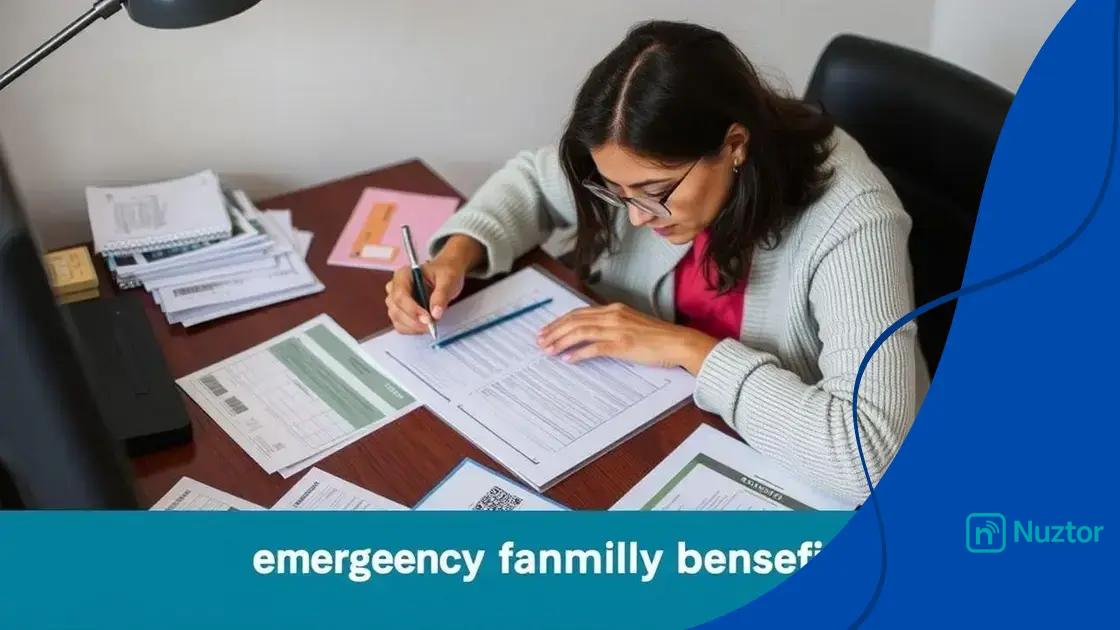Emergency family benefit flow: what you need to know

Emergency family benefits provide essential financial support to families in crisis, helping cover costs related to housing, food, and medical expenses, facilitating stability during challenging times.
Emergency family benefit flow plays a vital role in providing financial relief during challenging times. Have you ever wondered how this assistance actually works and who qualifies? Let’s dive in.
Understanding emergency family benefits
Understanding emergency family benefits is crucial for families facing financial hardships. These benefits are designed to provide temporary support during difficult times, ensuring your family has the resources to cope with unexpected challenges.
What are emergency family benefits?
Emergency family benefits generally include financial assistance to help with essential expenses like food, housing, and medical needs. Programs vary by state, but the goal remains the same: assist families in crisis.
Many families struggle to navigate the various options available. Knowing what is out there can make a significant difference. Let’s look at some common types of emergency support.
Types of emergency family benefits
- Temporary Cash Assistance: This provides direct financial help for immediate needs.
- Food Assistance: Programs like SNAP can help families access nutritious food.
- Housing Assistance: Programs that assist with rent payments or temporary housing solutions.
- Medical Support: Emergency funds to cover unexpected medical costs.
Applying for these benefits should be straightforward, yet many families encounter obstacles. It’s important to gather all necessary documents and understand the eligibility criteria for each program. This preparation ensures that you can act swiftly when support is needed.
For instance, if you suddenly find yourself unable to work due to an unforeseen circumstance, having a clear understanding of how to access these resources can provide peace of mind. Timing matters, and knowing how to act can lead to a quicker resolution.
In some cases, community organizations may also offer support. These groups can connect you with resources and help with the application process, offering a lifeline when you need it most. Don’t hesitate to reach out to local non-profits or social service agencies to explore the assistance available in your area.
Eligibility criteria for assistance
Eligibility criteria for emergency family benefits can vary significantly depending on the program and your specific situation. Understanding these requirements is crucial for accessing the support your family needs during a crisis.
General Requirements
Most programs share common eligibility requirements. Firstly, your family must demonstrate a financial need. This may involve providing proof of income, expenses, and any other resources you have. Additionally, your household size is taken into consideration, as benefits often depend on the number of dependents.
It is also important to be a resident of the state where you are applying. Different states have different regulations and available programs. Therefore, knowing your state’s specific guidelines is essential.
Income Limits
Income limits play a significant role in determining eligibility. Each program sets a maximum income threshold, which can differ based on family size. For instance:
- The greater your household size, the higher the permitted income limit.
- Many programs use the federal poverty level as a benchmark to evaluate eligibility.
- Income calculations may include wages, benefits, and any other sources of income.
Understanding these limits can help you assess if you qualify for assistance. If you find that your income is slightly above the limit, don’t lose hope. Some programs have a sliding scale that can offer partial benefits.
Documentation is a key aspect of the application process. Be prepared to submit various forms, including identification, proof of income, and family size information. Keeping these documents organized will make the application process much smoother.
Remember that eligibility is not purely about income. Some programs also consider situational factors, such as sudden job loss or medical emergencies. Therefore, clearly explaining your circumstances can prove beneficial when applying.
How to apply for emergency family benefits

Applying for emergency family benefits can seem daunting, but understanding the process can make it much easier. The first step is to gather all necessary documentation to demonstrate your family’s need for assistance.
Gather Required Documents
When preparing your application, having the right documents on hand is essential. These typically include identification, proof of income, expenses, and any other relevant financial information. Being organized will help streamline the process.
Here are some common documents you may need:
- Government-issued ID: This can include a driver’s license or passport.
- Proof of income: Pay stubs, tax returns, or bank statements should be included.
- Expense records: Keep track of your monthly bills such as rent, utilities, and food costs.
- Family size information: Documentation that shows the number of people in your household.
Once you have gathered all the required documents, you can start the application process. Most states allow applications to be submitted online, by mail, or in person. Choose the method that you find most convenient.
Filling Out the Application
When filling out the application, be sure to read each question carefully. Providing accurate information is crucial. If you’re unsure about what to fill out, consider reaching out to a local assistance program for help.
In some cases, the application might ask for details about your current situation. Explain your circumstances clearly to help the reviewers understand your family’s needs. This context can often influence the speed and outcome of your application.
After submitting your application, it is wise to follow up. This can help you confirm that your application is being processed and that all necessary documents were received. Knowing the status can provide peace of mind during a stressful time.
Finally, if your application is denied, don’t get discouraged. You usually have the right to appeal the decision. Each program has a process for this, and it’s important to understand your options for reapplying or appealing.
Common challenges in the application process
When navigating the application process for emergency family benefits, many families encounter common challenges. Recognizing these difficulties can help you prepare and address them effectively.
Documentation Issues
One of the most frequent hurdles is gathering the required documentation. Missing or incorrect documents can delay your application. Families often struggle to compile necessary paperwork such as proof of income, identification, or expense reports.
Here are some common documentation challenges:
- Lost Documents: Important papers can be misplaced, making it hard to prove your situation.
- Obtaining Proof: It may take time to get pay stubs or bank statements from employers or institutions.
- Organizing Information: Keeping track of many documents can be confusing, especially under stress.
To overcome these issues, create a checklist of all required documents. Check off items as you gather them to stay organized.
Understanding Eligibility Criteria
Another common challenge is understanding the eligibility criteria. Each program has specific requirements, and it can be hard to navigate them. Families might not realize they qualify based on their circumstances or income level.
Consider these points regarding eligibility:
- Complexity of Programs: Different programs have different rules, which can create confusion.
- Changes in Situation: A sudden job loss or medical emergency can alter your eligibility status but may not be fully understood by applicants.
Research your specific state’s guidelines to better understand what criteria you must meet. This knowledge will empower you during the application process.
Application Processing Delays
Once your application is submitted, waiting for a response can be another stressful aspect. Application processing times vary, and this uncertainty can lead to anxiety for families in need. Delays are often caused by high volumes of applications or additional information requests.
Keep these tips in mind to manage expectations:
- Follow Up: Check in on your application status to ensure it’s moving along.
- Be Patient: Understand that processing times can vary for legitimate reasons.
- Have a Backup Plan: Explore alternative resources in case of delays.
By anticipating these common challenges, families can approach the application process with a clearer strategy and hope for a smoother experience.
Real-life examples of support received
Understanding how emergency family benefits can help during tough times is often clearer through real-life examples. Many families have successfully navigated challenges with the support they received from these programs.
Case Study 1: The Smith Family
The Smith family faced sudden medical expenses when their youngest child was hospitalized. With both parents unable to work during this critical time, they applied for emergency cash assistance. This program provided them with funds to cover rent, bills, and groceries, allowing them to focus on their child’s recovery without the stress of impending financial crises.
Case Study 2: The Johnsons
After losing his job due to company layoffs, Mark Johnson realized they needed immediate help. By applying for food assistance through a local program, the Johnson family received benefits that ensured they did not go hungry while seeking employment. The support helped them avoid a crisis and regain stability.
Case Study 3: The Garcia Family
When the Garcias encountered housing instability after a fire damaged their home, they applied for housing assistance. They quickly received temporary housing support that provided them enough time to secure repairs and find a more permanent solution. This assistance was crucial in preventing homelessness during a very challenging period.
Each of these families illustrates how time-sensitive and impactful emergency family benefits can be. Their stories highlight the importance of knowing what resources are available and not hesitating to reach out for help when needed. While each situation is unique, the underlying message remains the same: support is available and can make a significant difference in times of crisis.
FAQ – Frequently Asked Questions about Emergency Family Benefits
What documents do I need to apply for emergency family benefits?
You will typically need identification, proof of income, expense records, and information about your family size to apply.
How do I know if I qualify for emergency family benefits?
Eligibility depends on factors such as income level, family size, and your specific situation. It is important to check the criteria for the program in your state.
What should I do if my application for benefits is denied?
If your application is denied, you can usually appeal the decision. Review the guidelines for the specific program to understand the steps for appealing.
How long does it take to process my application?
Processing times can vary by state and the program you apply to. It is best to follow up regularly to check on the status of your application.